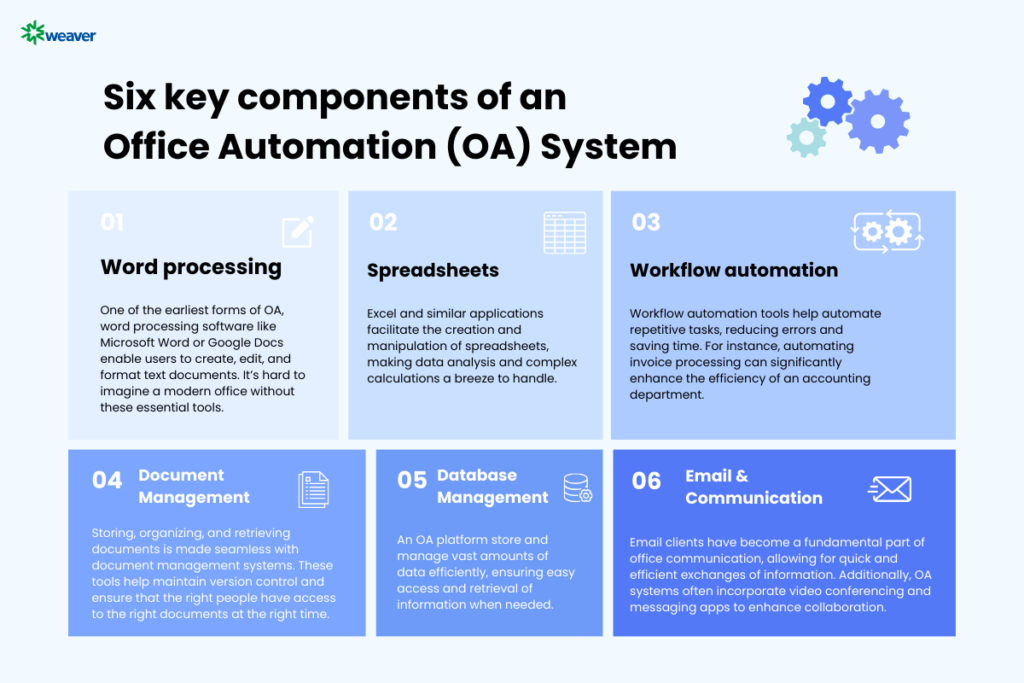What is an office automation system?
Office Automation (OA) systems have come a long way since their inception, transforming the way we work and boosting productivity across industries. As technology continues to evolve, we can expect OA systems to become even more intelligent, efficient, and user-friendly.
Embracing these tools is a strategic move for businesses looking to stay competitive in the digital age. In simpler terms, an Office Automation system is a suite of computer-based applications and devices designed to automate routine tasks and streamline workflows. These systems are a far cry from the traditional pen-and-paper methods office management, as they harness the power of technology to optimize various processes.
OA systems are not limited to any particular industry; instead, they are used across a wide spectrum of sectors, including finance, healthcare, education and more.
Is the term "OA" popular?
The term “OA system” are widely recognized and employed in many countries, as they refer to a set of tools and technologies designed to streamline office tasks and improve productivity.
How does an OA system work?

To understand OA systems better, let’s break down into their six key components and discover how does an OA system works:
1. Word processing
One of the earliest forms of OA, word processing software like Microsoft Word or Google Docs enable users to create, edit, and format text documents. It’s hard to imagine a modern office without these essential tools.
2. Spreadsheets
Excel and similar applications facilitate the creation and manipulation of spreadsheets, making data analysis and complex calculations a breeze to handle.
3. Workflow automation
This is where OA systems truly shine. Workflow automation tools help automate repetitive tasks, reducing errors and saving time. For instance, automating invoice processing can significantly enhance the efficiency of an accounting department.
4. Document management
Storing, organizing, and retrieving documents is made seamless with document management systems. These tools help maintain version control and ensure that the right people have access to the right documents at the right time.
5. Database management
An OA platform store and manage vast amounts of data efficiently, ensuring easy access and retrieval of information when needed.
6. Email and communication
Email clients have become a fundamental part of office communication, allowing for quick and efficient exchanges of information. Additionally, OA systems often incorporate video conferencing and messaging apps to enhance collaboration.
What does the future hold for the OA industry?
The potential growth for the Office Automation(OA) industry didn’t come out of the blue; it lies in its ability to address the challenges of the modern business landscape and provide opportunities for companies to develop solutions that meet the evolving needs of businesses. This has resulted in improved productivity, efficiency, and collaboration. This growth can be attributed to several key factors below:
- Increasing demand for digital transformation: Businesses are recognizing the importance of digital transformation to stay competitive and efficient. Office Automation solutions can help streamline processes, enhance collaboration, and improve overall productivity.
- Evolving workplace trends and demands: With remote work becoming more prevalent and the need for flexible and mobile solutions, the demand for Office Automation tools and software is expected to rise.
- Advancements in technology: As technology continues to advance, new and more sophisticated Office Automation solutions are being developed, offering innovative features and functionalities that cater to the evolving needs of businesses.
- Cost efficiency: Office Automation can lead to cost savings for businesses by automating repetitive tasks, reducing paper usage from printing, and optimizing resource allocation.
- Growing awareness and adoption: As businesses witness the benefits of Office Automation, more companies are likely to adopt these solutions, driving further growth in the industry.
With businesses worldwide gradually focusing on improving productivity and efficiency through digital transformation and streamlined workflows, the OA industry is expected to boom significantly over the years. So, whether you’re a small startup or a multinational corporation, exploring the possibilities of OA systems is a step toward a more efficient and productive future for both businesses and employees.
Contact Weaver for more customized enterprise OA platform services. Request your free demo today.
